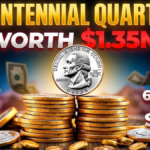The 1937-D Three-Legged Buffalo Nickel is one of the most mysterious and valuable coins highly coveted by coin collectors. Its special minting error and historical significance have pushed its price to extraordinary heights, with some specimens fetching as much as $270,000 at auction. This article will explain the origin, characteristics, and factors of this rare coin that are responsible for its exorbitant price
Buffalo Nickel History
The Buffalo nickel- by design, the Indian Head nickel- was minted within the United States between 1913 and 1938 and was sculpted by James Earle Fraser. Its a composite portrait of a Native American chief on the obverse side and an American bison (buffalo) on the reverse side. The design was to commemorate America’s frontier heritage and indigenous cultures.
How Was The 1937-D Three Legged Error Created?
In 1937, a very serious mistake was made at the Denver Mint (which would indicate a mint mark of “D”). Excessive polishing with a die caused the Buffalo’s right front leg to almost completely disappear. The error itself went unnoticed for a while, allowing them to circulate freely.
Factors Affecting This Coin’s Value
Such property is the one which causes the high price of this coin:
- Rarity: It is estimated that only 10,000 such flawed coins are in existence today, making it rarer than normal coins.
- Condition (Grade): The quality of the coin affects its price. Coins found in the highest grade (Mint State – MS) are especially valuable. For example, a coin with a grade of MS66+ was sold at the highest price at auction.
- Collector Demand: Because of this unique mint error, this coin is highly sought after among numismatists (coin collectors), which drives up its market value.

| Grade | Auction Price | Date | Auction House |
|---|---|---|---|
| MS66+ | $99,875 | 2021 | Legend Rare Coin Auctions |
How to Identify an Original 1937-D Three-Legged Nickel?
Because this coin is highly valued, counterfeit versions also exist on the market. Look for the following characteristics to identify a genuine 1937-D Three-Legged Buffalo Nickel:
- Missing Right Fore Leg: The buffalo is missing one leg due to a die polishing error.
- Weakness on the Bison’s Shoulder: There is a slight dimpling or pitting in the area where the leg should be.
- Die Characteristics: Genuine coins have distinctive die markings, such as a “porous” (moth-eaten) appearance on the buffalo’s hind leg.
Market Trends and Future Prospects
Over the years, prices for the 1937-D Three-Legged Buffalo Nickel have steadily increased, reflecting its popularity among collectors. The availability of high-grade specimens is diminishing, which is likely to further increase their price. However, market conditions are not always stable, so potential investors should do detailed research or consult coin experts before making a purchase.
Conclusion
The 1937-D Three-Legged Buffalo Nickel holds a unique legacy in the world of numismatics. Its historical error, rarity, and collectors’ interest have made it an extremely valuable piece of coin collecting. If you own this coin, be sure to have its authenticity checked, as it could prove to be a valuable part of your estate.
FAQs
1. Why is the 1937-D Three-Legged Buffalo Nickel so valuable?
A. Its rarity, mint error, and collector demand are responsible for its high price.
2. How can I identify a genuine 1937-D Three-Legged Buffalo Nickel?
A. Authenticity can be confirmed by looking for the missing right obverse leg and distinctive die markings.
3. What is the highest grade this coin has been given?
A. The highest known grade ever is MS66+, and coins with this grade sell for extremely high prices.
4. Are there counterfeit copies of this coin?
A. Yes, since this coin is so valuable, counterfeit versions are also available on the market. Have it checked by a certified dealer or grading service before purchasing it.















